Two new discoveries have confirmed December 21st of this year as the final day of the Mayan Long Count calendar, but what was going on at the beginning date in 3114 BC and did the Maya really invent the calendar? Hugh Newman investigates the mysterious origins of the Olmec civilization and the ancient ‘god’ Quetzalcoatl to explore the genesis of this incredible 5125-year cycle.
We are in the final year of the 13 Baktun Cycle of the Long Count Calendar, according to Maya Scholars. December 21st, or 4 Ahau, of this year, completes a 5125-year cycle that began on August 11th 3114 BC. In May and June of this year, two incredible discoveries were made in Guatemala that indicate the end date plus further dates thousands of years in the future within their wall paintings and inscriptions. In May 2012 at Xultun, a calendar glyph was discovered in what was described as “the ancient workroom of a Maya scribe, a record-keeper of Xultun” that projected dates four thousand years in to the future [1]. The other discovery, found one month later at the site of La Corona in Guatemala was a 1,300-year-old-year Maya inscription that is only the second known reference to the so-called "end date of the Maya calendar, December 21, 2012 [2].
The other prophetic inscription, is on Tortuguero monument 6 in Tabasco, that was originally translated by Sven Gronomeyer (2004) and re-translated in 2006 by David Stuart. It makes a reference to the end date of December 21st 2012. The La Corona and Tortuguero discoveries are the only surviving relics that pinpoint this enigmatic, upcoming end-date. The Tortuguero prophecy reads:
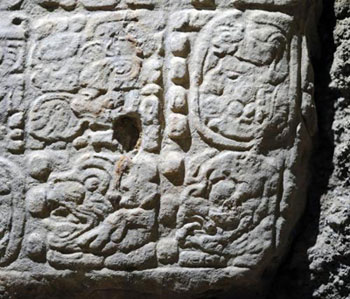
Figure 1 – La Corona 2012 Glyph
The thirteenth baktun will be finished
Four Ahau, the third of K’ank’in
(unreadable) will occur
(it will be) the descent of the nine support gods to the (unreadable). [3]
There have been further translations that vary in theme that Geoff Stray summarises. “Sven Gronemeyer, author of the most comprehensive study on the site of Tortuguero, and Barbara MacLeod, the originator of the "3-11 Pik Formula" (which shows evidence of precessional periods on an inscribed bone from Tikal), have combined forces and produced a revised study of Tortuguero Monument 6. They included many other epigraphers in their conversations about how the glyphs should be translated, and have even come up with a translation of the damaged glyphs. Here is the latest translation:”
It will be completed the 13th Bak’tun. It is 4 Ajaw 3 K’ank’in and it will happen a ‘seeing’.
It is the display of B’olon Yokte’ in a great ‘investiture’. [4]
Although the Spanish burned all the codices they could find of the ancient Maya, believing they were devil-inspired, four of them survived – the Dresden, Madrid, Paris, and Grolier codices. During the colonial period, various towns in the Yucatan possessed copies of a book named after the last great prophet, the Chilam Balam, or Jaguar Priest. [5]. The Chilam Balam books contain accounts of historical events, and prophecies and compelling evidence suggests they were originally prophecies concerning the end of the 13th baktun. It also gives a mention to ‘4 Ahau’, saying a catastrophe may happen in the era that ends on that day. Dr. Maud Makemson, a linguist and astronomer, translated the Chilam Balam of Tizimin and found the following prophecy: "…in the final days of misfortune, in the final days of tying up the bundle of the thirteen katuns on 4 Ahau, then the end of the world shall come… I recount to you the words of the true gods, when they shall come” [6]. Who these ‘gods’ are has been heavily speculated, but perhaps their ‘return’ suggests they were there at the beginning of the calendar, circa 3114 BC.
In an earlier part of the prophecy, it reads: "The Nine shall arise in sorrow, alas…And when over the dark sea I shall be lifted up in a chalice of fire, to that generation there will come the day of withered fruit. There will be rain. The face of the sun shall be extinguished because of the great tempest….Presently Baktun 13 shall come sailing,…. Then the god will come to visit his little ones. Perhaps "After Death" will be the subject of his discourse. ” [7]

Figure 2: Searching for Tortuguero in 2010
However, the prophecy concludes with a slightly more upbeat scenario: "Then finally the ornaments will descend in heaps. There will be good gifts for one and all, as well as lands, from the Great Spirit, wherever they shall settle down.”[8]
Literally hundreds of books have been written about what might happen in December 2012, ranging from total cataclysm, to enlightenment, or ascension. The Maya, as with almost all other ancient world cultures, believed that the earth, as part of its natural cycle of being, lives through a series of successive ‘world ages’, each separated by sudden physical planetary upheaval. The Aztec described the Fourth Sun ending with “torrential rains and floods” [9], whist the Fifth Sun was said to have begun in darkness in 3114 BC and was known as ‘The Sun of Movement’, that ‘the elders say; in it there will be a movement of the earth and from this we shall perish’ [10]. Whether this means earthquakes, or cometary impacts is unclear, but recording the cycles of the cosmos would be one way of predicting when the next cataclysm may happen.
THE MAYA CALENDARS
The Long Count Calendar:
It is generally believed that the Long Count calendar was established in ancient times to forecast or mark out the very transition points between these world ages. The basic ‘year-based-cycle’ is called a tun and consists of 360 days. The main recurring cycle consists of precisely 1872000 solar days (5125.36 years), which is theorised to be the very duration of each successive world age. The 13 Baktun cycle, is 13 periods of 144,000 days, and each Katun has 7,200 days, and so on. These are ‘precessional’ numbers that may be directly linked with the rare Galactic Alignment when the sunrise of this years winter solstice, has Galactic Centre behind sitting directly it. Long Count dates first start appearing in the archaeological record in the first century BC, although the Long Count’s formulation may have been in process for hundreds of years before then. Maya Scholar Munro Edmunson believes that the long count was put in place around 355 BC [11], although, as we’ll see soon, the Olmec were studying astronomy to a high degree of accuracy long before that, and appeared to have an understanding of precession.
The Haab Calendar:
The Haab cycle is the 360-day ‘secular’ calendar plus five extra days at the end of the year that synchronises with the Tzolkin calendar every 52 years. It consists of 18 months of twenty days each plus a nineteenth “month” of five days – the uayeb, and was mainly used for agriculture.
The Tzolkin
The Tzolkin of 260 days is the ‘sacred calendar’ that Quich’e calendar priest Andres Xiloj told ethnographers originally represented the gestation cycle of humans (around nine months), as the period of 260 days very closely approximates the interval between when a woman first stops menstruating and when her child is born [12]. It was also used to predict eclipses because "two tzolkin periods (520 days) equal three eclipse half-years (during which exactly three eclipses will occur)" (ibid p12). It is represented by 13 months of 20 days, with recognisable glyphs that were used for thousands of years.
The Calendar Round:
The Calendar Round was known to have been used by the Maya, Toltecs, Zapotecs and the Aztecs, and most probably the Olmec. It is a simple combination of the Tzolkin and the Haab calendars, synchronising a 260-day count alongside a 365-day count. Every 52 years or 18,980 days or 73 Tzolkins, it resets to Day 1. Massive festivities took place when this happened and pyramids would be rebuilt and the 52 year cycle always related to the return of the legendary Quetzalcoatal, who said he would return in the Year, 1 Reed.
The Venus Round:
The Maya developed many other calendrical systems, including tracking the course of the 584-day "Venus Round’, that was found within one of the three Maya books, the Dresden Codex [13]

Figure 3 – Tuxtla Statuette
According to archaeologists, not much was going on in Central America around 3114 BC. However Pre-Olmec cultures flourished in the area from around 2500 BC, and by 1800-1700 BC the earliest Olmecs had emerged, first around San Lorenzo, then throughout the Gulf Coast region. [14] Extensive farming and agricultural technology has been dated to between 4900BC and 4400 BC (ibid) in the area, but evidence of any type of ‘advanced culture’ had not yet been discovered. As we’ll see shortly, although the physical evidence is scarce, the legends, knowledge, and mathematics stretch back a lot further in time than original thought.
The deep origins of the Mayan calendars are still shrouded in mystery, but there is evidence that the Olmec were using both the Tzolkin and the Haab calendars by the 7th century BC [15]. Jenkins, as with many other scholars, did not believe the Long Count was invented at this time, as no dates can be found recorded before 36 BC (at Olmec site Chiapa de Corso) . This has made archaeologists think they projected backwards in time (and obviously forward in time to 2012). However, some interesting discoveries have been made over the last 110 years that may challenge this hypothesis.
In 1902 the Tuxtla Statuette was discovered by a farmer ploughing his field near La Majorra, next to the Tuxtla Mountains in Veracruz. This is the area where the seventeen colossal Olmec heads were quarried. Because of the unusual script on the artefact, it was sold on the black market and smuggled to New York hidden in a box of tobacco leaf. [16] The six inch nephrite piece was later acquired by the Smithsonian Institution and can still be seen at Dumbarton Oaks in Washington DC as part of the greater Smithsonian collection [17]. This remarkable find is a bullet-shaped humanoid with a weird duck-bill, that looks remarkably like the boat-billed heron (ibid). Seventy-five glyphs are inscribed in detail, showing an exquisite form of Epi-Olmec script (500BC – 500AD) with the Long Count calendar date of 162 AD, the earliest then known. The earliest known ‘Mayan’ date at the time was 228 AD, so this discovery caused quite a stir.
Another fascinating discovery was made at La Majorra in 1986, when it was pulled from the Acula River. The 41⁄2-foot-wide (1.4 m) by 61⁄2-foot-high (2.0 m), four-ton limestone slab contains about 535 glyphs of Epi-Olmec script. Until November 1995, the monument was in storage in the Museo de Antropología in Xalapa, but as it was being prepared for display, a previously neglected series of glyphs was spotted. On the edge of Stela 1, some badly weathered symbols were investigated by John S. Justeson and Terrence Kaufman by nighttime examination with artificial lighting. The slab has a Mayan-looking ruler with full regalia and headgear, and above his head there are two Long Count dates that correspond to May 21st 143 AD and July 13th 156 AD.
At Abaj Takalik, in southern Guatemala on stele 5 the date reads 8.3.2.10.15, which equates to May 19th 103 AD. Stela 2 at the same site has a date that is thought to be between 235 BC and 18 BC, although because it is so faded, it is impossible to pinpoint the precise date. “Charcoal found beneath the pavement on which Stela 2 was erected produced a date of 373 BC – 80 AD)” [18]
At El Baul, slightly further east in southern Guatemala, Stela 1 gives a date of 7.19.15.7.12, which equates to March 2nd 37 AD. Although these carvings were not in the Epi-Olmec style, but rather the Izapan style, both these sites have strong Olmec influences in their stonework and style.

Figure 4 – La Majorra
In 1939 another important discovery was made back in the Gulf Coast region. Archaeologist Matthew Stirling had only just unleashed his team on the Gulf Coast a year earlier under the supervision of the Smithsonian Institution, when at Tres Zapotes, he discovered the bottom half of what became known as Stela C. The date on it clearly showed 7.16.6.16.18, which correlates in our present-day calendar to September 1st, 32 BC, although there was some controversy over the missing Baktun.
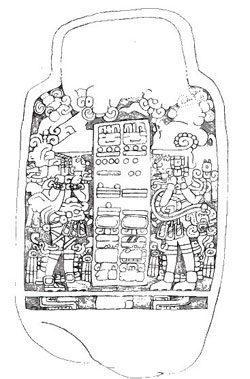
Figure 5 – Stela 5, Abaj Takalik
The first digit, which Marion Stirling, Matthew’s wife, had suggested could be a ‘7’ which would confirm the 32 BC hypothesis. This was validated in 1969 when the top half of the stela was found. "The glyph at the bottom of the left column specifies that this day was 6 Etz’nab in the Ritual Almanac; the jaguar head in the Introducing Glyph represents the patron deity of the Solar Year calendar month in which the date falls, although the precise position in the Solar Year system (Haab) is not specified." (ibid)

Figure 6 – Tres Zapotes. 32 BC Long Count Date
Tres Zapotes was topped by a discovery at Chiapa de Corzo, the indigenous capital of Chiapas. Although the site is mostly now destroyed by development, a small part of it is now open to the public. An inscribed wall panel shows the date 7.16.3.2.13 and that can equate to 6th December in year 36 BC. However, the only full glyphs are kins, uinals and tuns. It can also be a ‘Ben’ day, either 7 Ben or 6 Ben, which could alter the whole date. So what we are seeing is a vital part of the dating system ‘missing’. Without this piece of the inscription, the dates could be much older. I contacted a Maya calendar researcher, (who wishes to remain nameless) to see if he could come up with some alternative dates if the missing piece had these two different numbers on it. He came back with these tantalising calculations:
1. 8.15.3.2.13 7 Ben 1 Sip Jun 23 340 AD
2. 7.16.3.2.13 6 Ben 16 Xul December 6 36 BC (standard interpretation)
3. 6.10.3.2.13 6 Ben 1 Chen May 24 548 BC
4. 5.10.3.2.13 7 Ben 16 Kayab Feb 13 942 BC
5. 6.16.3.2.13 7 Ben 11 Muan Sep 3 430 BC
6. 4.17.3.2.13 7 Ben 16 Ch’en Nov 13 1199 BC
7. 3.11.3.2.13 7 Ben 1 Keh May 1 1711 BC
8. 2.18.3.2.13 7 Ben 1 S’otz Jan 23 1967 BC
9. 1.12.3.2.13 7 Ben 6 Xul Jul 12 2480 BC
10. 0.19.3.2.13 7 Ben 11 Pax April 4 2736 BC
11. (OLD ERA) 19.13.3.2.13 7 Ben 16 Kumk’u Sep 21 3249 BC (not too far away from 3114BC – the start of the Long Count).

Figure 7 – Chiapa de Corzo. 36 BC
12. 4.11.3.2.13 6 Ben 6 Sip Aug 3 1317 BC
13. 3.18.3.2.13 6 Ben 11 Mak April 27 1573 BC
14. 2.12.3.2.13 6 Ben 16 Muwan oct 15 2086 BC
15. 1.19.3.2.13 6 Ben 16 Yaxkin July 8 2342 BC
16. 0.13.3.2.13 6 Ben 1 Yax Dec 25 2855 BC
17. (OLD ERA) 18.14. 3.2.13 6 Ben 6 Sotz March 6 3623 BC_(not too far away from 3114BC – the start of the Long Count).
So until this final inscription is discovered, it is impossible to say which one of these it would have been.
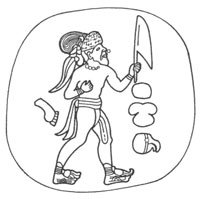
Several other strange calendar-looking glyphs have been discovered in the Olmec area. At La Venta, for instance, Monument 13 shows a turban wearing, curled-shoe Phonecian-looking man standing with a scythe or flag, but below him are three un-deciphered glyphs (see pic on right). He was sometimes called "The Ambassador" by early Mexican and European archaeologists, supposedly meaning an ‘Ambassador’ from a Mediterranean city such as Carthage, Tartessos, Tyre or Byblos [19].

Figure 8 – San Andreas Calendar Seal. 650 BC
In December 2002, scientists reported on the "Earliest form of writing ever found in the New World". A small calendar seal and greenstone plaque fragments were discovered at San Andres, just next to La Venta, that were estimated to date to around 650 BC. The cylinder seal clearly shows ‘3 Ahau’, the name of a recognisable day in the sacred 260 Tzolkin calendar. 4 Ahau is the forthcoming December 21st 2012 date. This puts the Long Count Calendar, and now the Tzolkin, way beyond the era of Maya. Also at San Andreas, early Maize pollen was discovered dating to 3100 BC. A ‘manoic pollen’ dating to 2600 BC and domesticated sunflower seeds dating to 650 BC were also found suggesting a prolonged period of agriculture, and therefore, probably use of calendars, to decide on the planting times of crops. The 3100 BC date stands out, due to its correlation with the 3114 BC start date of the Long Count. Cotton was also discovered that dated to 500 BC [20].

Figure 9 – Cascajal Block, Veracruz
Another interesting discovery was made four years later in Veracruz once again, although no calendar dates were deciphered from it. It is made from serpentine, a highly valued stone that was also used in the 27-level mosaic floor pit at La Venta. Dated to around 900 BC and with the same headline as the 2002 discovery (Earliest Inscription etc), this 36cm x 21cm x13cm block is definitely the oldest known writing in the Americas. The Cascajal Block was originally discovered by road builders in the late 1990s in a pile of debris in the village of Lomas de Tacamichapa in the Veracruz lowlands. The style is not Epi-Olmec or any other known language, so it has left researchers baffled. It could represent an early form of one of the calendars, but is so far apart from any of the three known calendars styles at the time, that this stays purely in the realm of speculation.
An earspool with a calendar glyph on it, discovered at Cuilcuilco, in Mexico City, was dated to 679 BC. [21]. This site has a remarkable circular, stepped pyramid that Archaeocryptographer Carl Munck, worked out was a geodetic marker on a grid of ancient sites across the planet. He claimed that the number of layers and steps were mathematically derived and encoded its own coordinates in a global mapping system. The site is covered in an ancient lava flow that that was first excavated by Mexican Archaeologist Manuel Gamio in 1917. The dating of this lava made the site famous. Although the site is now dated to around 250BC, the lava flow that covers much of the pyramid was originally dated to 5000 – 6500 BC. Back in 1923, National Geographic were the first to report on this incredibly ancient date. The author of the piece was archaeologist Byron Cummings, who became fascinated by the site because Geologist George E. Hyde estimated the age of the flow to be at least 7,000 years old, suggesting that the pyramid must have been even older than that. In the on-site museum some unusual artefacts including what looked like figurines with oriental eyes and some with big sunglasses on, had an eerily Olmec look about them. A strange blue light even appeared above the pyramid when they began to excavate it in 1917. Apparently the workers were delighted, thinking it must contain ancient Aztec treasure. None was found, but a geological map of the area may explain the blue lights that were first witnessed during the excavation, due to it being on a fault line that aligned with other volcanoes in the region.
Carbon dating of sediment on the paths around the pyramid, gave a more conservative date of around 250BC, but the mysterious calendrical earspool, dated to 679BC, and the Olmec figurines, may still retain a certain level on antiquity and place it firmly in the realm of the Olmec.
Some other unusually early dates have been noted in carbon dating that originally took place at the Olmec capital, San Lorenzo in 1931. Charcoal from wood identified as Palm was excavated and a date of 2260 BC +-100 was recorded. In the notes associated with the test it said "Comment: too old, perhaps some asphalt lumps present". Perhaps also that there were no asphalt lumps present, and it was in fact that old. Olmec writing has also been found at Kamalinjuya, in Guatemala, a site that is dated to 2,500 BC, only 614 years after the enigmatic 3114 BC calendar start date.
La Venta is one of the most important sites in Central America. As well as containing the oldest known pyramid in the New World, it was also used to study the stars over great expanses of time to a startling degree of accuracy, suggesting a potential ‘Long Count Calendar’ connection. "Archaeoastronomicval investigation has shown that the pyramid at La Venta was intentionally aligned toward the polar area of the sky and to specific stars in the Big Dipper. The level of precision in these alignments is quite impressive. However the effects of precession inevitably caused these alignments to "go out of sync", and the Olmec astronomers and temple-builders responded by periodically reorienting the pyramid. Their solution, however, was bound to be temporary, for precession would once again cause a misalignment between the stars and the pyramid. Nevertheless, the realignments of La Venta’s pyramid provide evidence that Olmec astronomers were aware of precession" [22]. But how would they be able to track precession, a 26,000 year cycle? John Major Jenkins found a very simple solution, "Precession causes the rising time of a prominent star such as Spica to shift about 1 degree in seventy-two years. 1 degree is twice the width of the moon", so Jenkins argues, they would notice it within one lifetime and could be by passing it down generation to generation. At La Venta, its precise orientation to the circumpolar stars, would have made it easy to track the changing in the risings of stars on the horizon. "The pyramid realignments at La Venta make sense only if we allow that the Olmec were keenly interested in calibrating precession" (ibid).
Jenkins believes that precession was directly linked with the Long Count, as this extremely rare alignment only occurs every 25,771 years. Every 6450 years, the earth also line up with galactic centre, with the seasonal quarters (equinoxes and the summer solstice etc) [23]. Five 13-baktun cycles (5 x 5125.36) equal 25,627 years, which is only 144 years/Haab’s difference from precession, or two degrees of precession. Remember that 144,000 days is one Baktun cycle, so the harmonic of ‘144’ fits neatly into this ‘system’ the Maya and most probably the Olmec were using.

Figure 10 – Cuilcuilco, Circular pyramid.
The layout of La Venta is exactly 8 degrees west of true north. Originally thought to be a basic mistake, this misalignment caught the attention of archaeologist Marion Popenoe Hatch in the early 1970’s, and later by Andrew Collins in The Cygnus Mystery. Hatch determined that the site’s pyramid, built c. 1000 BC, was aligned towards the stars of both Ursa Major (the Big Dipper) and Sadr (gamma Cygni) the central star in Cygnus. Her astronomical analysis found they were both used to determine the time of the summer solstice, a tradition she traces back to 2000 BC through computer calculations. The symbol in Maya texts used to represent Cygnus she has identified as the cross bands glyph, which appears also on much earlier Olmec statues of the ‘were-jaguar’. This, she suspects, signified the starry sky. Cygnus can be seen as a key constellation in Olmec and Mayan astronomy, a point previously not recognised by everyone until Hatch decoded the site.

Figure 11 – La Venta. Notice the 8 degree off-set
Further investigation showed that at midnight on 21st June, on the eastern horizon, the Pleiades star cluster could be seen rising, whilst 180 degrees away due west, the observer would see Scorpio starting to set on the horizon, meaning that the Milky Way would have trailed down from the meridian, where Cygnus was at its zenith, to the position of Scorpio in the west. [24]. Cygnus, Leo, the Pleiades and Scorpio all played a part in dividing the year up in to four equal segments as they reached their zenith on the solstice or equinox. Most notably, the December solstice had Leo transiting the meridian at midnight, with Cygnus in direct opposition to it. Hatch believed this would have continued like this for nearly a thousand years (ibid). "Due to precession, the centre point of the bowl was now slightly askew of north, and would have been seen to disappear below the horizon at as azimuth of eight degrees west of north – exactly the same orientation as La Venta". [25]

Figure 12 – La Venta. Young Olmec and Pyramid.
La Venta was the only Olmec site with this 8-degree alignment. Dr H Mike Xu of the University of Oklahoma believes the north-south axis of other Olmec sites were related to magnetic north, and not to astronomical considerations. It is interesting that a magnetometer survey in 1967 found a magnetic anomaly high on the south side of the pyramid at La Venta. [26].
At San Lorenzo, a mysterious lode-stone artefact was discovered, that after analysis by John Carlson, was said to have possibly been used to align sites north-south and could have "geomantic principles", in a very similar way to which Chinese geomancers would have done so, "and no function for the object other than that of a compass pointer has been suggested by anyone who has examined it critically" [27].

Figure 13 – Stela 19: Quetzalcoatl at La Venta
From the minute information available on the Olmec calendar, Andrew Collins points out that, "It would seem that they recognised a 52-year cycle thought to have been anchored by a triple conjunction of Venus, Saturn and the Sun on the summer solstice 810 BC. It had been proposed by R L hall of the University of Chicago, after the earlier work of Munro Edmonson, that the Olmec-Maya Long Count was established 260 years later on a date which coincided with the termination of the Olmec calendar round. Yet this suggests it was instituted in 550BC, and not 355 BC as proposed by several Mayan scholars" [28]
The question remains, did the Olmec devise the calendar that ends on December 21st 2012? Did they recognise precessional cycles and foresee that particular end-date? From the extensive calculations decoded by Hatch, it can be seen that their understanding of the night-sky and time science was probably one of the most advanced systems in the world at the time. They understood the 260-day Tzolkin calendar as far back as 679BC, had Haab dates correlating with the 52 year calendar round, and from Hatch’s calculations, could have been studying precession and the annual (Haab) calendar as far back as 2000BC.
Enter Quetzacoatl, the teacher god of ancient America, who also had associations with 52 year cycles, Venus, and carried one of the most controversial beards in history.
Quetzalcoatl is one of the oldest gods of Mesoamerica, who was said to have arrived on the Gulf Coast of Mexico in extreme antiquity. This white-skinned deity was credited with introducing advanced mathematics and calendrics that made their way in to the Olmec and Maya pantheon [29]. Quetzelcoatl was also called the plumed or feathered serpent and has startling similarities to Virococha of the pre-Incan tradition in Peru. Introducing some of the arts of civilization and banishing all sacrifice, except for "flowers and plants", twenty of these long-robed men arrived in Coatzalcoalcas, or ‘Serpent Sanctuary’, long before the eye of history.
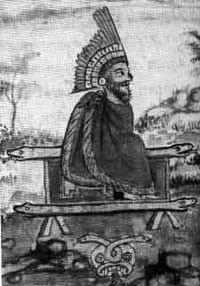
Figure 14 – Spanish version of Quetzalcoatl
The myths and legends of these ‘gods’ have been systematically slammed by the academics, but even the Spanish were bewildered by how so many locals had fond memories of what were described as being more of a ‘man’ than a ‘god’, dating to, perhaps, around 5000 years ago, the era of the start of the Long Count Calendar. Along with thousands of detailed codices, paintings and calendars, the prehistoric myths and legends were systematically destroyed by the Hernan Cortez and the Spanish in the 1500’s, so finding evidence about Quetzalcoatl is scarce, and because they arrived in the year ‘1 Reed’, the same year the Aztec astronomers prophecised he would return, these fair-skinned, bearded Spanish invaders had an easy time rampaging through Mexico, because the local Aztecs believed the great god and his ‘band of followers’ had returned.
"The great god Kukulcan, or Feathered Serpent, was the Mayan counterpart of the Aztec Quetzalcoatl, the Mexican god of light, learning and culture. In the Maya pantheon he was regarded as having been the great organiser, the founder of cities, the former of laws and the teacher of the calendar. Indeed his attributes and life his tory are so human that it is not improbable that he may have been an actual historical character, some great lawgiver and organiser, the memory of whose benefactions lingered long after death, and whose personality was eventually deified." [30].

Plumed Serpent painting at Juxtlahuaca cave.
(Photo by Matt Lachniet, University of Nevada at Las Vegas.)
Throughout the Olmec world, feathered serpents have been represented in art and reliefs, such as Monument 19 at La Venta (see fig. 13) and a painting in the Juxtlahuaca cave that is thought to be dated to around 1200 – 900 BC ([31]
The Temple of the Feathered Serpent, a pyramid at Teotihuacan, and the immense Cholula pyramid in Peubla are also dedicated to Quetzalcoatl: "It is generally accepted that Quetzalcoatl’s cult was immensely ancient, originating in prehistoric times in Central America and thereafter receiving the devotion of many cultures during the historic period" [32].
There are reports of Quetzalcoatl having ‘large eyes and a high or broad forehead’. In the Xalapa museum there are some skulls with ‘high foreheads’, the incredible elongated skulls that have also been found throughout Peru and in Egypt. Were these the skulls of the ‘gods’? The fair skin theory also fits in here because the hair and skin pigment (on some of the ones in Peru and the Pacific islands) show a caucasian race with red and blond hair [33] and not dark hair, which is natural in Central and South America. In Olmec carvings we also find several that clearly show bearded men, the most famous of them found at La Venta, being labeled ‘Uncle Sam’, due to his Caucasian face with a high-bridged nose and long, flowing beard. Matthew Stirling unearthed this fourteen-foot high stela which is now set up in La Venta Park in Villahermosa. There are several other carvings at La Venta that show Caucasians mixing with African-looking and Oriental-looking people. Even in Monte Alban near Oaxaca, dated to around 500 BC, the same racial features are also shared in the stonework.

Figure 15 – Temple of Quetzalcoatl, Teotihuacan
The controversial author, Zechariah Sitchin, travelled to the Olmec region in the year 2000 and noticed at Xalapa museum, that the earliest date referring to the Olmec was 3000 BC. However when he returned a few years later, it had been changed to 1500 BC [34]. In his book Lost Realms he told a convincing theory of how the Egyptian god Thoth was banished from Egypt at around 3100 BC and made his way over to Mexico. He said he got further corroboration of the 3114 date when astronaut Gordon Cooper in chapter 11 of his book A Leap of Faith said this.
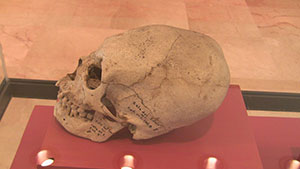
Figure 16 – Skull at Xalapa Museum, Veracruz
"During my final years with NASA, I became involved in a different kind of adventure: undersea treasure hunting in Mexico." One day, accompanied by a National Geographic photographer, they landed in a small plane on an island in the Gulf of Mexico; local residents pointed out to them pyramid-shaped mounds, where they found ruins, artefacts and bones. On examination back in Texas, the artefacts were determined to be 5,000 years old! "When we learned of the age of the artifacts," Cooper writes, “we realized that what we’d found had nothing to do with seventeenth-century Spain… I contacted the Mexican government and was put in touch with the head of the national archaeology department, Pablo Bush Romero." Together with Mexican archeologists the two went back to the site. After some excavating, Cooper writes, "The age of the ruins was confirmed: 3000 B.C. Compared with other advanced civilizations, relatively little was known about this one –called the Olmec." However, there is no detail of which island it was, how they dated the artefacts, or what exactly was discovered, so this speculative research, is, as Coopers title suggests, a ‘leap of faith’, but worth a quick mention here.

Figure 17 – ‘Uncle Sam’ at La Venta
Around the time of the beginning of the Long Count calendar c. 3114 BC, a worldwide explosion in culture was happening. (info from Wikipedia).
– In Egypt the reign of the ‘Followers of Horus’ came to an abrupt end, and the Pharoanic age began with Narmer, or Menes, the ‘Scorpion King’, who started ruling around 3100 BC.
– Not long before this, hieroglyphs were first being used in Egypt.
– According to Vedic scriptures, in 3102 BC, the beginning of Kali Yuga, bought in a new age in India.
– Construction of the Ħaġar Qim megalithic temples in Malta, featuring both solar and lunar alignments. The "Tarxien period" of megalithic temple construction reaches its apex.
– The earliest phase of Stonehenge begins, with the outer earthwork ditch and bank, and a now lost timber circle may have once existed within the main henge.
– Newgrange in Ireland’s first phase of construction
– Skara Brae, Orkney Islands, Scotland is inhabited.
– Anu Ziggurat and White Temple in Uruk, Mesopotamia (modern Warka, Iraq) are built.
– Humans develop their first writing system, cuneiform script.
– Gobekli Tepe, in Southern Turkey, was already 7,000 years old.
– The Giza pyramids would be built around 500 years later.
Whoever inaugurated the Long Count Calendar in Mexico, had been studying the stars for potentially millennia. They were shamans, farmers, astronomers and megalith builders, and taught the arts of civilization and high culture. Whether they came from across the sea, or were already residents of Mexico, what appeared to be a multi-cultural society flourished on the Gulf Coast from at least 1800 BC. They eventually developed into the famous ‘Maya’ c.100 BC, who took mathematics and calendar science to an incredibly high degree at sites such as Izapa and Abaj Takalik. The deep history of recording precession from generation to generation was carried out worldwide, with good evidence that it was also happening in Mexico, the country that instigated one of the most enigmatic cycles our current culture has ever witnessed. They knew a 5125-year count would end on December 21st 2012, in the era of the ‘galactic alignment’, a cosmological event they knew they would never see themselves. Perhaps the ancient peoples were prophecising a ‘golden age’ around 2012, much the same way as we hark back to another ‘golden age’ around 3114 BC. It is unlikely that Queztalcoatl will return on December 21st 2012, but perhaps his philosophy of peace, higher consciousness and love will emerge through all those that want something better in this world.
Hugh Newman is an author, conference organiser, world explorer, tour host, and one half of Pentos Television. As an author he has researched the Indigo child phenomenon and published a book on the subject. His most recent book, Earth Grids has been published by Wooden Books. He has released a DVD based upon his research in Mexico – Before the Maya: The Olmecs, Quetzalcoatl and the Megalithic Origins of Mesoamerica, filmed at Megalithomania in 2010. His latest DVD is entitled: The Olmec Origins of the Mayan 2012 Calendar, available at www.pentos.tv. He has articles published in The Leyhunter, Mindscape Magazine, World Explorer Magazine, The Circular, The Spiral, The Heretic and numerous other publications. As well as organising the Megalithomania conferences, he has spoken at events in the UK, Malta, France, Peru, Bosnia and North America. He has appeared on BBC TV, Sky Channel 200, Bosnian TV and the History Channel in three series of Ancient Aliens. He is currently writing a book about the Wandlebury complex near Cambridge. He is organizing a tour to Mexico with David Hatcher Childress in March 2013 to visit many of the sites outlined in this article. See www.megalithomania.co.uk/mexico2013.html for more info.
| See Hugh’s upcoming tour for more:
|
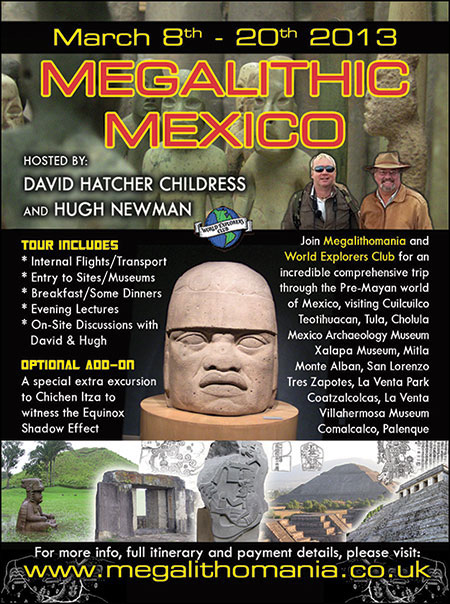 |
References
- http://news.nationalgeographic.com/news/2012/05/120510-maya-2012-doomsday-calendar-end-of-world-science/ [back to text]
- www.sciencedaily.com/releases/2012/06/120628181735.htm [back to text]
- David Stuart, 2006 [back to text]
- http://www.diagnosis2012.co.uk/new11.html [back to text]
- Stray, article: www.grahamhancock.com/forum/StrayG1.php?p=4 [back to text]
- Tizimin p.15 [back to text]
- Tizimin pp.15-16 [back to text]
- Stray article: www.grahamhancock.com/forum/StrayG1.php?p=4 [back to text]
- Graham Hancock, Fingerprints of the Gods, p107 [back to text]
- Adela Fernandez, Pre-Hispanic Gods of Mexico, p.24 [back to text]
- John Major Jenkins: http://www.levity.com/eschaton/Why2012.html [back to text]
- John Major Jenkins, Maya Cosmogenesis 2012, p19 [back to text]
- Mark Heley, The Everything Guide to 2012, p27 [back to text]
- Diehl, Richard A. The Olmecs: America’s First Civilization. London: Thames and Hudson. pp. 9–25. [back to text]
- John Major Jenkins, Maya Cosmogenesis 2012 pp.19-20 [back to text]
- Diehl, Richard 2004. The Olmecs: America’s First Civilization. Ancient peoples and places series p25 [back to text]
- David Hatcher Childress, The Mystery of the Olmecs, p200 [back to text]
- John S. Henderson, The World of the Ancient Maya. Cornell University Press, 1997 p.90 [back to text]
- David Hatcher Childress, The Mystery of the Olmecs, p215 [back to text]
- Pope, Kevin; Mary E.D. Pohl, John G. Jones, David L. Lentz, Christopher von Nagy, Francisco J. Vega, and Irvy R. Quitmyer; "Origin and Environmental Setting of Ancient Agriculture in the Lowlands of Mesoamerica", Science, 18 May 2001:Vol. 292. no. 5520, pp. 1370–1373. [back to text]
- Munro Edmonson. The Book of the Year: Middle American Calendrical Systems. Salt Lake City: University of Utah Press. [back to text]
- John Major Jenkins, Maya Cosmogenesis 2012, p7 [back to text]
- John Major Jenkins, Maya Cosmogenesis 2012, Introduction [back to text]
- Hatch, ‘An hypotheses on Olmec Astronomy, with Special Reference to the La Venta Site’, pp.1-38, reprinted from Contributions of the University of California Archaeological Research facility; Papers on Olmec and Maya Archaeology 13, June 1971(p.5.) [back to text]
- Andrew Collins, The Cygnus Mystery, p61 [back to text]
- http://en.wikipedia.org/wiki/La_Venta#Major_features_of_La_Venta. [back to text]
- Lodestone Compass: Chinese or Olmec Primacy?, Science, 5th September 1975, vol 189 no. 4205 pp.753-760. [back to text]
- Andrew Collins, The Cygnus Mystery, Notes p.313 [back to text]
- Lewis Spence – The Magic and Mysteries of Mexico p22, Hancock, Fingerprints of the Gods p109 [back to text]
- Sylvanus Friswold Morley, An Introduction to the Study of Maya Hieroglyphics (Introduction by Eric S. Thompson), Dover Publications Inc., New York, 1975, pp. 16-17 [back to text]
- Coe, Michael D, "Image of an Olmec ruler at Juxtlahuaca, Mexico", Antiquity Vol 79 No 305, September 2005. [back to text]
- Graham Hancock , Fingerprints of the Gods, p142 [back to text]
- B. Foerster, lecture at Megalithomania, May 16th 2012: http://www.megalithomania.co.uk/foerster-crimson-horizon.html [back to text]
- http://www.sitchin.com/astronaut.htm [back to text]







